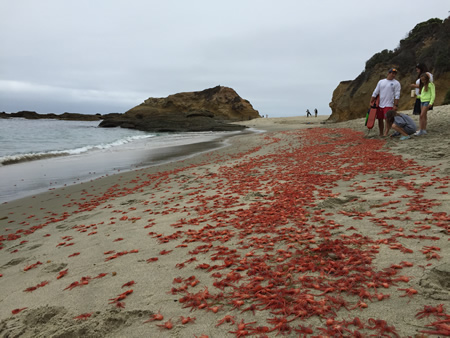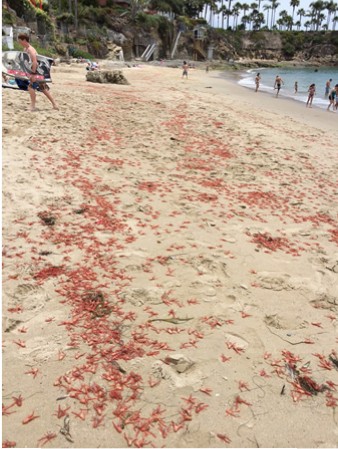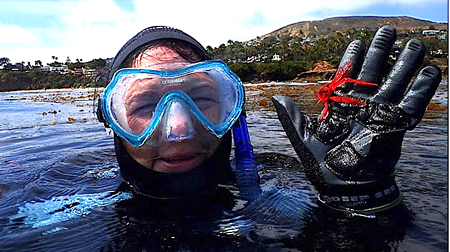
Tide-pool educator Letty Skeen was surprised to see a blanket of hundreds of bright red crabs, mostly dead, lining the shore when she arrived at Treasure Island in South Laguna on Monday, June 15.
At the tide pools, she found about 20 still alive, fortunately sequestered in the rocky water bowls.
Almost translucent with dark eyes, a short lobster-like body, fanned tail and finger-like pinchers, the red crab swims backwards, like a squid. “They’re kind of jet-propelled when they go through the water,” said
Skeen, head of the Laguna Ocean Foundation docent program. The crab is named after its biggest predator.
Tens of thousands of tuna crabs washed up on Orange County beaches as far north as Bolsa Chica, riding a warm-water current off the Baja California coast, said David Bader, education director for the Aquarium of the Pacific in Long Beach.
Along with the new spiny findings, residents are also complaining of tar globs on the sand even as some of Laguna’s beaches received high marks in an annual water-quality report.

The small crabs are also known as pelagic red crabs and scientifically as Pleuroncodes planipes. They live in the open sea, bobbing on the surface most of the time, said Bader. Bader saw crabs as far north and south as he could see at the Huntington Beach pier Monday. “It was a spectacle. When they hit shore, they’re definitely in trouble,” he said.
“For months and months,” said Jeremy Frimond, Laguna Beach’s marine protection officer, “people two, three miles out have reported seeing acres and acres of these guys floating around.” The amount of tuna crabs drifting up on beaches this year is admittedly remarkable, he said.
Known as an El Nino warm-water season, currents bring warm ocean waters 500 miles up from Baja California about every 10 years, according to the National Oceanic and Atmospheric Assn. Combined with southerly winds, a south swell and water temperatures averaging five to 10 degrees higher than average, even last winter, unusual tropical-sea creatures are showing up near shore.
“The water never actually got cold this winter,” said Bader. There’s no upwelling, when deep cold water comes to the surface, bringing cold-water nutrients and small fish for marine animals such as the sea lions to eat, he said. The conditions have caused malnourishment and eventual starvation for hundreds of sea lions.
Sea lions are specialists when it comes to cuisine and won’t eat shell fish like red crabs or even spiny fish like bass, Bader said. Other animals such as sea birds, whales and tide pool residents will partake, he said. Visitors to the Treasure Island tide pools watched as shore crabs, sea anemones and tide-pool sculpin dined on dead red crabs, Skeen reported
Other not-as-unusual finds are also rolling up on the beach, like tar balls, while bacteria counts in beach water atypically are in decline.

“Today, Anita, Thalia and Oak streets beaches in Laguna had large deposits of oil and tar the size of golf balls,” reported resident Garth Jorgensen on Monday. Jorgensen wondered about a correlation to the South Coast oil spill in Santa Barbara in May.
Clumps of tar are showing up on Los Angeles beaches as well, said Chris Gibson, marine science technician in the incident management division for the U.S. Coast Guard in Los Angeles. Samples from L.A. and Orange county beaches are being examined to determine the tar’s origin, he said.
Tar balls float and can travel, depending on water and air currents, said David Valentine, professor of earth and marine science at UC Santa Barbara, who has been studying the South Coast spill onsite. If the tar is seepage from beneath the ocean, it will contain old organic matter, Valentine said.
“We were told by the Coast Guard that there’s less than 1 percent on our shore and the tar looks old,” Frimond said. “It’s an awful coincidence. We do have pockets of oil, we do have oil rigs out there and we have natural seepage from the earth.” Oil clumps in the sand go way back, decades and generations, he said, leaving many a beachgoer’s foot black and sticky.
The annual Heal the Bay Top 10 Beach Bummer List and Honor Roll for all state beaches was also announced at the Santa Monica Pier this week. Two Laguna beaches made the top grade, which is determined by dry and wet weather run-off results in summer and winter, said Sarah Sikich, vice president and chief scientist for Heal the Bay.
Treasure Island Beach and Tutuava Beach in south Laguna received highest honors. While receiving an A+ year-round, Main Beach, the city’s most popular with out-of-towners, missed the Honor Roll since there were no county test results from November to March, said Matthew King of Heal the Bay.
The rating is determined by the amount of fecal bacteria in the water, which is tested weekly by local counties, said Sikich. The fecal matter from humans and animals, such as dogs, is analyzed for pathogens that make people sick, she said.
The drought has ironically improved ocean water quality, even at beaches with chronic low marks, due to lack of run-off, said Sikich. “It’s a strange silver lining to our water-supply problem,” she said. The beach at the guest dock in Dana Point Harbor and Balboa Beach at the Wedge in Newport Beach were also high-scorers this time around.
Although contributing to ocean pollution, manmade contaminants, such as chemicals from sunblock and fertilizers, are not directly tested, she said.
For the first time in years, an Orange County beach dropped to the Beach Bummer F-list, she said. Huntington Beach at Brookhurst Street is the 10th worst beach in the state. “It was the best of the worst,” she said.




